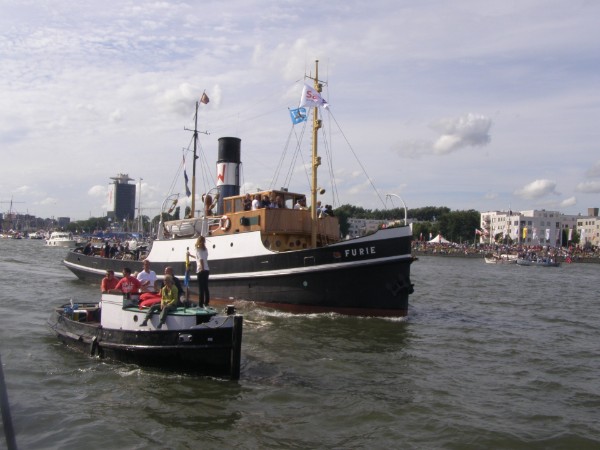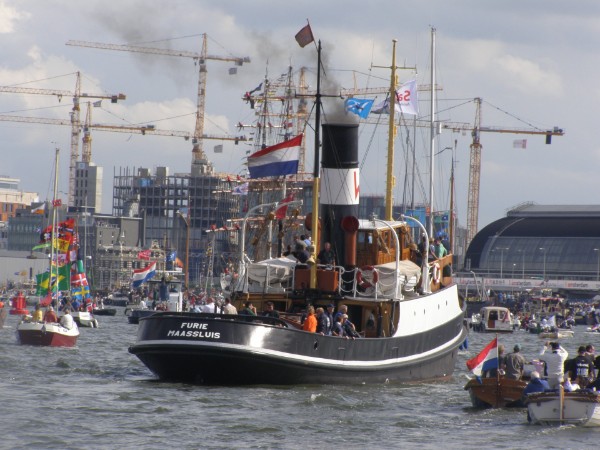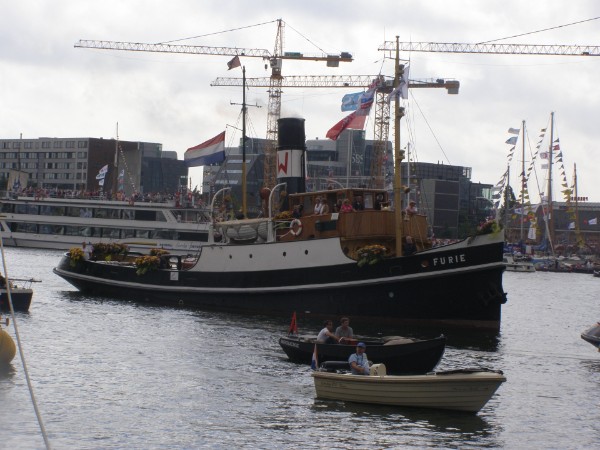Furie
The Furie is the last existing sea-tug driven by steam in The Netherlands. She was built in 1916 at the wharf of the brothers G. & W. Bodewes at the village of Martenshoek in the north of The Netherlands. The wharf built the ship for their own account, in the hope to sell her on the German market. But because of the first worldwar, nothing of this came to pass and the ship was laid-up under the name Bodewes VI.
Below is the Furie, seen at the Sail Amsterdam 2010 festivities in august 2010. She still looks like a massive tug, although she is almost 100 years old now she can compete in size to modern day harbourtugs.

The ship was finally sold in 1918 to Holmen Bruks & Fabriks AB of Norrköping, Sweden and she sailed for Sweden with the name SVERIGE (Sweden) painted at her sides in large scripting to show her neutrality. She recieved the name Holmen III after arriving in her new homecountry and she was used here untill 1969 to ship woodfloats across the Baltic Sea. In the Swedish and Finnish woodcutting industry it was normal to throw the cut-down trees in the rivers and let them float downstream towards the mouth of the river, where they were grouped into large floating piles of wood, sometimes up to 400 meters in lenght. The maximum amount of wood towed by the Holmen III was around 9000 cubic meters. The ship brought the wood from the rivermouths to paperfactories in Norrköping or Hallstavik. In the 1960's trains and trucks were replacing the tugboats and the captain of the Holmen III bought the ship and sailed her in the vicinity of Stockholm untill 1976 under the name of Holmvik.

Originally, the tug had an open bridge and one mast. Later, in the 1950's, the second mast was added and the steering cabin was closed in. Also, the main deck was rebuilt like it still looks today. The ship measures some 158 tons, her lenght is 30 meters, she is 6 meters wide and she has a draft of 3 meters. The technical installations are still original from the time when she was built, including the steampowered stearing gear and the 450 IPK tripple-expansion steamengine. She was reverted from coal to oil-burning in 1957.
Her comeback to Holland, the country of her birth, was rather unexpected. The broadcast corporation AVRO wanted to create a television-series based on a book called Hollands Glorie (Dutch Glory), written by Jan de Hartog in 1940. The book is about a captain of a steamtug, named Jan Wandelaar (in English we could call him Johnny Walker...) who starts up a company in sea-tugworks. For this series, the AVRO needed a sea-steamtug, next to 64 actors. But in The Netherlands, the kind of steamtug needed was not available anymore. But they discovered the Holmvik when the director of the series saw a picture of the ship and he knew this was the ship he as looking for. So the Holmvik was bought and brought over to IJmuiden where she was rebuilt for her new role as a television-star. After six weeks, work was finished and the ship was towed to Ireland, where the first part of the series was shot at Castletown, Bantry Bay. First, she revieved the name Jan Van Gent but this was later changed to Furie and she kept this name ever since. After sailing in Ireland for seven weeks, the Furie came back to Holland, where more shots were made for the series at the IJsselmeer. The series ran in 1977 and 1978 under the same name as the book, Hollands Glorie.
When the series ended, the Furie was sold to a company from Zaandam, close to Amsterdam, and laid up. But in 1978, she was bought by several people from Maassluis, close to Rotterdam, who founded a company to operate the ship from here. Maassluis has always been an important town in sea-tug history, because it was the main port for the tugs of the internationally well-known tugcompany Smit from the end of the 19th century onwards. So this ship was the only possibility for Maassluis to again have an old sea-tug that could be used to educate people about the history of tugs. On the 17th of fabruary 1978, the Furie arrived at Maassluis and this became her new homeport from then on. The ship was restored and kept sea-worthy so she could be a sailing and working museum by itself.

Furie is now a well-known sight all over The Netherlands on festivals, daytrips and there even is a special festival organized for her in Maassluis under the name of Furiade. This festival originates from 1980, when it was organized when the ship entered her new service and since then it is held every year. The festival has grown into a big event, where a lot of ships are present, including some historic steamships. Of course, Furie still in the central focus.

